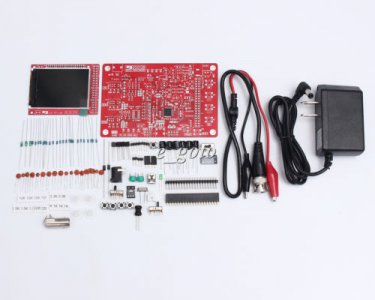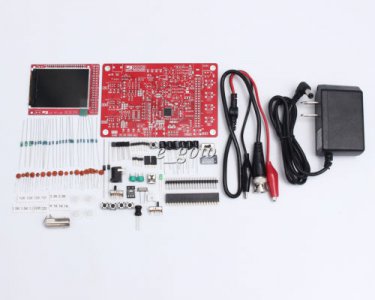I probably should keep my mouth shut for the sake a sounding like an old fuddy-duddy eschewing new technology. But in the pursuit of providing help to others in this forum, and given the fact that electronic instrumentation is clearly one of my fields of expertise I just HAVE to jump in here.
WARNING: Long, tedious commentary to follow...
I admire the things that folks have been doing with all the Arduinos and PLA type devices available today. Much of that technology enables macro design thinking and frees the designers from the arduous details of micro assembly, writing machine code, etc. But what it doesn't facilitate is the sometimes obvious (simple) means to facilitate an end. In this case, developing a useful, accurate, (remote) digital readout.
From an engineering standpoint I have long been dealing with brilliant digital engineers whose understanding of coding and programming astounds me. But when they have analog issues in their designs I am called in to resolve issues of often trivial proportions because somewhere in the 80's Electrical Engineering and Digital Engineering became separated. Digital, in so many ways, is still analog.
Your noted author, Yuriy, clearly suffers from a distinct lack of formal approach. Lack of schematics and a fundamental dirth of analog understanding was clearly demonstrated in going through all his lengthy instruction. Which is not to diminish his accomplishments, but his success is not guaranteed in his approach, nor is it optimized by obtaining any predetermined metric to shoot for from the outset. For example, his attributions of “noise” problems and ground loops was for the most part astoundingly ill-assessed, but not irrelevant.
That being said...
You specific problem is , ultimately, you wish to add reliable DRO functionality to your machine. My first question must be, does it HAVE to be remote? With the possibility of programming hundreds of set-points sitting in your easy chair, I can't really imagine what capability is added by being able to remove the readout some distance from the source of the work. But if this is absolutely required, so be it. If not, I think your iGaging scales can be easily plugged into any “conventional” DRO and youre done. My entire DRO and three scales for my Bridgeport all came in under $500.
On the other hand, to pursue the remote app approach doesn't seem to require what you think. Scopes and analyzers are wonderful devices when needed. I don't think they will help in this regard however. All of the signals from scale to interface and interface to BlueTooth xmtr are ultimately data levels. Either on or off, their rise-times, and even timing, are not so critical that a scope would give you any more information than a decent meter.
To simplify matters, the major difference in the two approaches described are thus.
Scales:
Quadrature Scales: Like the iGaging, preferably glass, scales output a set of data pulses which lead or lag each other by 90 degrees (hence the name Quadrature) to establish a count of incremental movements. This is pretty much the same for all scales; two data lines, 5 volt logic levels. What they plug into must do several things. FIRST and FOREMOST, it must capture EVERY pulse!!! Since the pulse rate is determined in the analog world this can sometimes be difficult for digital devices to do. But in this case, I believe the MSP430 Controller is plenty fast enough to handle that. Second, it must determine what the value of each increment is, update a value (decimal value), and assign it a channel (X, Y, or Z) to send to the display in a binary format. According to Yuriy, the iGaging scale even matches the MSP430's 3.3 volt input, so no level shifting will be required in the interfacing.
All the other measurement devices, (I'll call them “digital” for lack of a better term) develop a numerical value internally and communicate this via USB. They differ in that some use a 21 bit format, others a 24 bit, and maybe some other vaugeries of data transfer readily dealt with in software of the controller. Yuriy does a pretty good job of describing the functional pros and cons of these devices. What he missed however was that the timing of communications is far less critical. In fact, if the controller completely fails to acquire a count (like a cable gets pulled out) it will simply reacquire the data when it's plugged back in. For quadrature scales, everything would have to be re-zeroed. Considering the likelihood of some digital glitch interrupting things (computers never hang-up, do they?) I think that's a pretty big benefit to have not highlighted.
Within these two basic methods there are additional subtle variables which Yuriy addresses well enough that I needn't repeat him.
Given that you already have what I believe is a set of Quadrture scales, you should be able to interface the 3.3volts power and D+,D- lines to an MSP430 controller according to Yuriy's description. Using the display component that comes with those scales seems untenable as they appear to lack a serial data output.
By all means however, I encourage you to investigate buying a simple scope. Scopes are GREAT tools! My first big investment as a fledgling Engineering Tech was an old scope. However, having a scope serves no means to an end unless you already know what you're looking for and why a scope is the required instrument to observe the phenomena. For example, analog scopes are essential at things like determining phase relationships to tweak servo controllers and feedback devices. I don't know why digital scopes don't do Lissajous patterns, but I digress. Yuriy showed on one page where he used the scope to set a trip point for the level shifting on a scale interface. This is a grey area as this could have been set with a simple meter, but the scope excelled at displaying the effect. They also excel at displaying problems related to impedance mismatch, waveform deformation, and many other time-domain relationships. I'm just not sure you'd find their particular attributes particularly beneficial in this pursuit. Old analog Tektronics and HPs are easy and cheap to come by. For digital, Rigol seems to be a great investment for the money.
Briefly, digital analyzers are far more specific in application. They benefit from being able to capture the data states of a large number of lines based upon a specific condition, or trigger state. They generally do not make much determination of signal level, quality, etc. I do have one digital scope (HP 54201D) that will trigger on conditional data, which is the best of both worlds, but I've used it only a few times in 20 years for that purpose. Unless you think you'll be getting into the on-board data storage and communications of the controller board I don't believe this helps you at all.
I hope this clarifies some of the issues which confront you in this project. It sounds like a fun project. However, I would prefer to lessen the parts count, rely less on software and get to making swarf.
Aside: I saw a great demonstration yesterday of a Drone. Remarkable machine, flies where programmed by GPS, returns sharp pictures, just amazing. But it took more than an hour fiddling with the Smart Tablet to establish reliable communications because a recent OS upgrade insisted on asking for several (unneeded) options to be configured every time the app booted. I don't have that kind of time and patience anymore.
Best of luck,
Mark S.
(whew!)



